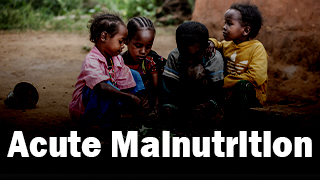Acute Malnutrition
Recently the World Health Organization (WHO) in its press brief stated that acute malnutrition is risking 30 million children’s lives.
Global state of Malnutrition:
§ According to WHO, Currently, more than 30 million children in the 15 worst-affected countries suffer from wasting — or acute malnutrition.
§ 8 million of these children are severely wasted, the deadliest form of undernutrition.
Causes
§ Conflict, climate shocks, the ongoing impacts of COVID-19 and rising living costs are leaving increasing numbers of children acutely malnourished.
§ Meanwhile, critical health, nutrition and other life- saving services are becoming less accessible.
Impacts:
§ The global food crisis is also a health crisis, and a vicious cycle: malnutrition leads to disease, and disease leads to malnutrition.
§ Acute malnutrition is a major threat to children’s lives and their long-term health and development, the impacts of which are felt by individuals, their communities and their countries, the WHO added.
Malnutrition in India
· Despite decades of investment to tackle this malaise, India’s child malnutrition rates (which contributes to a third of the global burden of undernutrition) are still one of the most alarming in the world.
· The Global Hunger Index (2022), which is calculated on the basis of total undernourishment of the population, child stunting, wasting and child mortality, places India at the 107th spot among 121 countries
UN’s response: Global Action Plan on Child Wasting
· Action Plan:
In response to the WHO’s report, five UN agencies subsuming WHO are calling for accelerated progress on the Global Action Plan on Child Wasting.
- Food and Agriculture Organization (FAO),
- UN Refugee Agency (UNHCR),
- United Nations Children’s Fund (UNICEF),
- World Food Programme (WFP) and
- World Health Organization (WHO)
Aim:
The action plan aims to prevent, detect and treat acute malnutrition among children in the worst-affected countries:
o Afghanistan, Burkina Faso, Chad, the Democratic Republic of the Congo, Ethiopia, Haiti, Kenya, Madagascar, Mali, the Niger, Nigeria, Somalia, South Sudan, Sudan and Yemen.
· Need of support, action & investment:
§ The agencies have called for decisive and timely action to prevent this crisis from becoming a tragedy for the world’s most vulnerable children.
o All agencies urged greater investment in support of a coordinated UN response that will meet the unprecedented needs of this growing crisis before it is too late.
Government initiatives to address Malnutrition
· Poshan Abhiyan:
§ It is a multi-ministerial convergence mission with the vision to ensure the attainment of malnutrition free India by 2022.
§ The Ministry of Women and Child Development (MWCD) is implementing POSHAN Abhiyaan.
Prime Minister’s Overarching Scheme for Holistic Nutrition (POSHAN) 2.0 scheme:
· It now includes the Integrated Child Development Services (ICDS) scheme, which seeks to work with adolescent girls, pregnant women, nursing mothers and children below three.
· Integrated Child Development Services (ICDS):
§ It represents one of the world’s largest and unique programmes for early childhood care and development.
§ The beneficiaries under the Scheme are children in the age group of 0-6 years, pregnant women and lactating mothers
§ The Ministry of Women and Child Development is the implementing agency.
· Mid-Day Meal Scheme:
§ The Mid-day Meal Scheme is a school meal programme in India designed to better the nutritional standing of school-age children
§ It covers all school students studying in Classes 1 to 8 of government schools, government-aided schools, special training centres, including madrasas supported under Samagra Shiksha Abhiyan.
· National Food Security Mission:
§ It was launched in 2007-08 by the Ministry of Agriculture and Farmers’ Welfare as a Centrally Sponsored Scheme.
§ It focuses on the sustainable increase in the production of targeted crops through area
expansion and productivity enhancement.
· National Nutrition Mission:
§ It is the government’s flagship programme to improve nutritional outcomes for children, pregnant women and lactating mothers.
· Aim: To reduce stunting and wasting by 2 percent per year (total 6 per cent until 2022) among children and anemia by 3 percent per year (total 9 per cent until 2022) among children, adolescent girls and pregnant women and lactating mothers.
· The Ministry of Women and Child Development is the nodal ministry for implementation.
